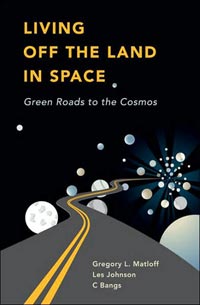|
|
Review: Living Off the Land in Space
by Jeff Foust
Monday, October 22, 2007
Living Off the Land in Space: Green Roads to the Cosmos
by Gregory L. Matloff, Les Johnson, and C Bangs
Copernicus Books, 2007
hardcover, 250 pp., illus.
ISBN 978-0-387-36054-6
US$27.50
Throughout human history, explorers have taken advantage of the resources surrounding them to carry out their journeys, from harnessing the wind for travel across oceans to gathering food and other supplies in distant lands. An exception to this, by and large, has been humanity’s exploration beyond Earth. Other than using solar panels to generate electricity, human and robotic missions alike have tended to take with them (or depend on frequent resupply from Earth) everything they needed, from the propellants in their launch vehicles to the food and water consumed by their human crews. Such an approach sharply limits what humans can do in space, and for how long. A sustainable long-term presence in space certainly requires a different mindset about the use of in-space resources, and also new technologies, many of which are profiled in Living Off the Land in Space.
The book is written by a pair of scientists: Gregory Matloff, who has studied issues associated with long-term space exploration for many years; and Les Johnson, a physicist at NASA Marshall who is the former manager of the agency’s In-Space Propulsion Technology Project. (The third author, C Bangs, is an artist who produced a number of collages that open each chapter.) The authors spend the first part of Living Off the Land in Space looking at various broader issues associated with space exploration, from the variety of destinations in the solar system (and beyond) for missions to the rocket equation and the limitations it puts on the use of conventional chemical propulsion. In the second part of the book, the authors turn their attention to various technologies, primarily alternative means of propulsion, that could open the solar system in ways not sustainable by conventional technologies: solar sails, tethers, ion propulsion, and the utilization of in situ resources on other worlds, among others. These are the “green” technologies alluded to in the title and elsewhere in the book: not because of any impact they have on the Earth’s environment but because of the potential they have to lessen or eliminate any dependence on the Earth.
| The “green” technologies alluded to in the title and elsewhere in the book are not so named because of any impact they have on the Earth’s environment but because of the potential they have to lessen or eliminate any dependence on the Earth. |
The book is a mixed bag. It takes the authors some time in the first part of the book to get going on the subject of sustainable exploration technologies, as they flit from topic to topic, from past robotic exploration of the solar system to proposed interstellar probes to minutiae like what sorts of appliances one might find in the kitchens of space colonies. The second part of the book, though, has a sharper focus, with the authors examining a range of potential propulsion and related technologies. (That momentum is broken briefly by the seemingly non sequitur addition of a chapter on space plaques, like the ones flown on the Pioneer and Voyager spacecraft, between chapters on solar sails and tethers.) The book aims to be relevant by limiting themselves to technologies either under development or in limited use today; that’s presumably why the space elevator, a promising if long-term space access technology, is dismissed in about a page in a chapter devoted to near-term use of electromagnetic tethers. To emphasize this, the authors devote a chapter to “technology readiness levels”, the scale used primarily by NASA to assess the viability of various technologies; most of the technologies the authors consider have modest TRL ratings, although they do spend one chapter near the end on far-future technologies, like antimatter propulsion and zero-point energy, that have TRLs of effectively zero.
The authors note near the end of Living Off the Land in Space, with some disappointment, that the schedules and budgets proposed for NASA’s Vision for Space Exploration initiative prevent the agency from utilizing much in the way of new technology, like the propulsion systems proposed in the book. “NASA had to begin designing flight hardware now—using mostly existing technologies—and innovation would have to wait,” they write (emphasis in original). This book offers a look at what might be possible when—and if—schedules and budgets permit the use of more advanced technologies that could allow future explorers to loosen their bonds to the Earth.
Jeff Foust (jeff@thespacereview.com) is the editor and publisher of The Space Review. He also operates the Spacetoday.net web site and the Space Politics and Personal Spaceflight weblogs. Views and opinions expressed in this article are those of the author alone, and do not represent the official positions of any organization or company, including the Futron Corporation, the author’s employer.
|
|
